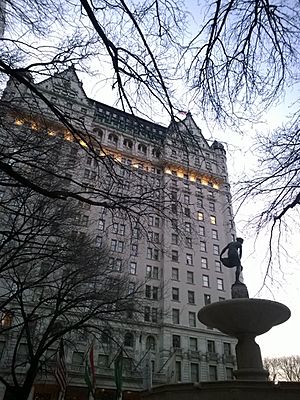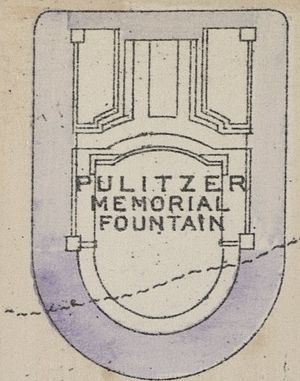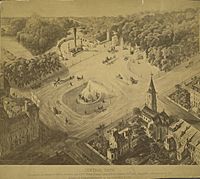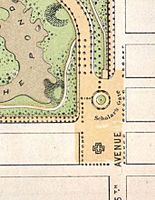Pulitzer Fountain facts for kids
Quick facts for kids Pulitzer Fountain |
|
|---|---|
| Artist |
|
| Year | 1916 |
| Type |
|
| Medium |
|
| Subject | Pomona |
| Dimensions | 6.7 m (22 ft) |
| Location | New York City, New York, United States |
| 40°45′51″N 73°58′25″W / 40.76403°N 73.97361°W | |
The Pulitzer Fountain is a famous outdoor fountain. It is located in Manhattan's Grand Army Plaza in New York City. The fountain is named after Joseph Pulitzer, a well-known newspaper publisher. He passed away in 1911 and left $50,000 in his will to create this fountain. Pulitzer wanted his fountain to look like the beautiful ones in the Place de la Concorde in Paris, France.
The architect Thomas Hastings designed the fountain. A statue by sculptor Karl Bitter sits at the top. The fountain was officially opened in May 1916.
Contents
History of the Pulitzer Fountain
How the Fountain Was Designed and Built

In December 1912, the people in charge of Joseph Pulitzer's will announced something exciting. New York City had approved the perfect spot for the fountain. This spot was in the plaza between 58th Street and 60th Street. It was just east of Fifth Avenue. The Sherman Monument was already in this plaza.
They invited five architecture companies to compete. They wanted the best design for the fountain. They also wanted ideas for making the whole plaza look good. In January 1913, all five designs were shown at the New York Public Library. The winning design was by Carrère and Hastings.
Architect Thomas Hastings decided to put the fountain in the southern part of the plaza. The Sherman Monument stayed in the northern part. It was moved a little to be directly across from the fountain. Hastings' plan for the fountain included a special figure. This figure would represent something important.
Building the fountain started in 1915. By November, a newspaper said the Pulitzer Fountain was finished. It was "bubbling with the purest Croton water." Work on the northern part of the plaza was delayed. This was because of subway construction.
The final design featured a bronze statue called Pomona. It was created by Karl Bitter. Pomona is the goddess of abundance. She holds a basket full of fruit. The person who modeled for the statue was Doris Doscher. Sadly, Karl Bitter passed away on April 9, 1915. He had just finished the plaster model of the statue. So, Hastings and Bitter's wife chose Isidore Konti to finish it. Konti started work in late 1915. The statue was cast in bronze in April 1916. It was put in place around May 1, 1916, without a big ceremony.
Restorations of the Fountain
1933–1935 Renovation
In 1933, Joseph Pulitzer's sons, Herbert, Joseph, and Ralph, gave $35,000. This money was for fixing up the fountain. Architect Dan Everett Waid oversaw the work. The project was delayed a bit by worker issues. But it was finished by June 1935. During this work, the fountain's limestone basin was rebuilt. They used beautiful Italian marble instead. Also, the limestone fence and columns around the fountain were removed.
1971 Renovation
In 1971, the Parks Department started another restoration. August Heckscher led this project. It cost $268,000. The work included a new sewer system. They also replaced the limestone steps with strong granite.
1974 Landmark Status
On May 30, 1974, a special group called the New York City Landmarks Preservation Commission held a meeting. They wanted to make the Grand Army Plaza, including the Pulitzer Fountain, a "Scenic Landmark." This means it's a very important and protected historical place. The idea was approved on July 23, 1974.
1985–1990 Renovation
On March 26, 1985, the Central Park Conservancy and an architecture firm presented new plans. They wanted to fully restore the plaza and the Pulitzer Fountain. The plans included putting back the fence and columns. These had been removed in the 1935 repairs.
The work was finished in June 1990. The fountain was rebuilt, this time using granite. However, the plans to put back the fence and columns were stopped. This was because of the high cost. According to The New York Times, the fountain used to just drip water. But after this renovation, it now "cascades." This means the water flows down in a beautiful stream. This change made the Pulitzer Fountain sound wonderful.
Gallery






